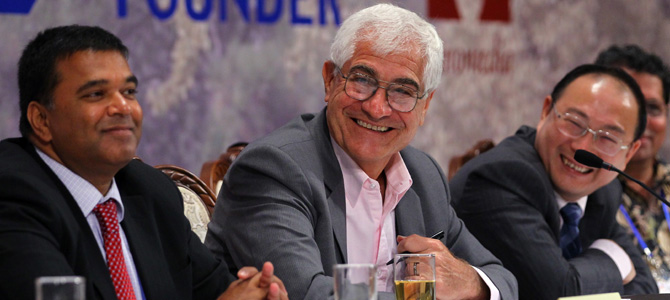
Alstom, the world's third-largest power equipment maker, is boosting its investment in hydro power in China, as other renewable energy sectors such as wind and solar energy face a slowdown.
Alstom Renewable Power, Alstom's division in charge of renewable power generation equipment and services, plans to establish a Global Technology Center in Tianjin, as part of a 100 million euro ($123 million) investment to upgrade Tianjin's hydro industrial facility - the largest such plant that Alstom has in operation.
"Compared with other renewables, hydro power is very stable," said Jerome Pecresse, president of Alstom Renewable Power.
And as the renewable sector - including wind and solar - develops, the demand for pumped-storage plants will also increase, according to Pecresse.
Alstom is one of China's leading hydro producers. The company has contracts for hydro turbines and generators covering about 47 gigawatts, out of which about 50 percent are already in commercial operation.
Alstom was also involved in the construction of the Three Gorges Dam, the world's largest power plant of any kind, to which it supplied 14 of the dam's 32 units, each with an output of 700 megawatts.
"International hydro power companies are setting up their research and development centers in China to grab more market share, leading to fierce competition as well as more mergers and acquisitions," said Zhou Xiujie, an industry analyst with China Investment Consulting.
According to the China Electricity Council, the country's hydro power investment reached 44.4 billion yuan ($7 billion) in the first five months of the year, up nearly 50 percent year-on-year.
With a temporary slowdown in the construction of nuclear plants after the Fukushima disaster in Japan, the Chinese government is pushing ahead with all forms of renewable energy: solar, wind, bio-energy, geothermal and hydro.
However, the development of wind and solar energy is slowing down.
Authorities began tightening approval for wind power projects last year after a significant amount of wind resources were wasted because the grid was not capable of carrying or sending out the electricity.
Despite the government's ambitious push, the solar market in China is still very small, with less than 3 gW installed at the end of 2011.
In comparison, hydro power makes up 22 percent of the country's installed power base, with many large hydroelectric projects either in the planning stage or under construction. The country's hydro market is booming, with installed capacity for hydropower increasing by 15 gW every year, and expected to reach 380 gW by 2020 from just under 200 gW this year.
China plans to get 11.4 percent of its energy from renewable sources by 2015, of which hydro power will contribute two-thirds, analysts said.
In the first half of the year, the central government has approved six major dam projects totaling 8.8 gW, with another 10 gW in the pipeline by the end of the year, according to the National Development and Reform Commission.
China's hydropower capacity stood at 230 gW at the end of 2011, 22 percent of the total, and another 55 gW are now under construction, according to figures released by the National Energy Administration.
The country's hydro power market slowed down during the 11th Five Year Plan period (2006-10) partly due to controversy about its environmental impact. However, new approvals accelerated since 2010 when the reduction of carbon emissions was at the top of the government's agenda.
Meanwhile, the slowing economy may pose some challenges for hydro power development as demand for electricity is cooling down.
liuyiyu@chinadaily.com.cn


 Washington to remain focused on Asia-Pacific
Washington to remain focused on Asia-Pacific RQFII target blue chips amid bear market
RQFII target blue chips amid bear market Australian recall for top two exporters
Australian recall for top two exporters China fears new car restrictions
China fears new car restrictions